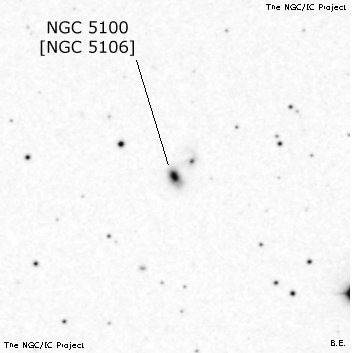NGC/IC Project Restoration Effort
(This is a very very beta version)
NGC5106


Basic Information
Location and Magnitude
Right Ascension: 13:20:59.5
Declination: +8:58:44
Constellation: VIR
Visual Magnitude: 13.9
Historic Information
Discoverer: Herschel W.
Year of discovery: 1784
Discovery aperture: 18.7
Observational
Summary description: vF, vS, PD very doubtful
Sub-type: S?
Corwin's Notes
=====
NGC 5106 is possibly NGC 5100. There are some problems remaining. Here is
the story:
WH saw the nebula on just one night, and recorded only the right ascension,
not the north polar distance. The GC and NGC note the polar distance as "v
doubtful." The NGC carries a brief note: "Not found by Tempel (A.N. 2522);
at least there was no 2nd class nebula near the place." Dreyer has a longer
note in his edition of WH's complete papers: "Sw[eep] 108. 'A vS and F neb
sp 59 Virginis [= SAO 119847]. Its A.R. is about 13h 06 1/4m. While I looked
into the finder to determine its situation, I lost it, but shall endeavour to
find it another night.' The transit is given as 13h 10m, that of 31 Bootis
(Sweep 111) as 14h 30 1/4m. It is probably = Marth 255 (NGC 5100), 35s p, 30'
n of the assumed place of II.22; no neb in H's place." In his NGC corrections
based on the WH edition, Dreyer simply says, "II.22 must be = 5100."
There is no problem with NGC 5100. Marth's position is very close to
Bigourdan's which is, in turn, very close to the GSC's. It has a small
companion which is mentioned in the CGCG, MCG, and UGC, though was apparently
not seen by Marth or Bigourdan. And N5100 is indeed 35s p, and 30' n of the
NGC position. All this supports Dreyer's contention of the equality of the
two NGC numbers.
However, JH makes no mention of how he determined the polar distance which he
used in GC for N5106 (Dreyer simply copied the NPD into NGC). If we assume
that JH used the NPD of 31 Bootis for II 22, then the GC/NGC PD is more than
30 arcmin in error -- it should read 81 18.1 rather than the 80 46.5 it does.
Also, regardless of the NPD, WH's RA places II 22 south-following 59 Virginis,
not south-preceding as he states.
So, questions linger around this object. Unless WH's or JH's unpublished
notes can shed some light on this, we have to regard the identity of N5106
with N5100 as provisional.
-----
In CH's fair copy of the sweep in the Herschel Archives, I found this:
A nebula so small that I lost it again while I looked into the finder.
31 Bootis p 1h 20' 15" - - - - RA 13h 11' 34" PD betw. 80d 28', 81d 54'.
CH has shortened her brother's comments a bit, but the time of the observation
(the transit) is still given to a full minute only. This makes the RA also
uncertain.
Finally, the mean of the 1800 polar distances (probably the limits of the
sweep) is 81d 11m. For J2000, the position then becomes 13 21 36, +07 45.9,
with a range in RA of 30 seconds, and a range in Dec of 43 arcminutes. This
is 1.2 degrees away from NGC 5100; even JH's GC position is half a degree from
the galaxy. Thus my concern.
For now, I'm willing to follow Dreyer's lead, but I am going to change the
colon that I had put on the number to a question mark, and my "probably" in
the first sentence of this note to "possibly."
Steve's Notes
=====
NGC 5106
See observing notes for NGC 5100. The equivalence with NGC 5100 is uncertain and Reinmuth and Carlson identify NGC 5106 with a star.



